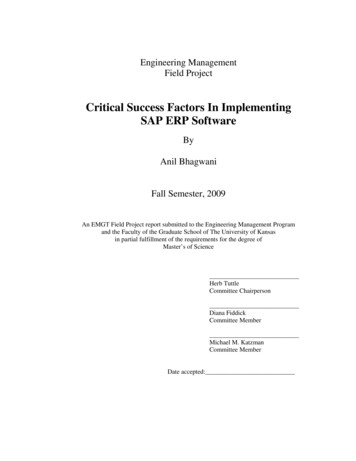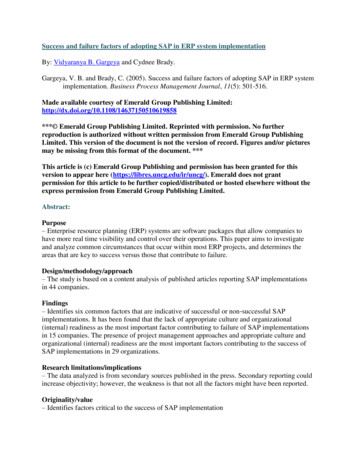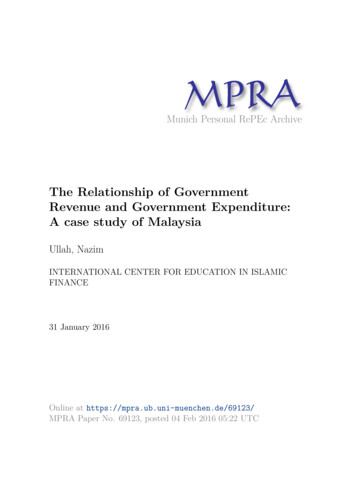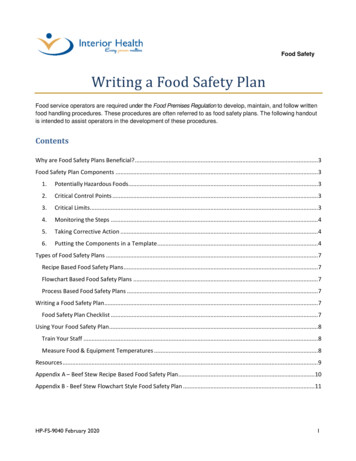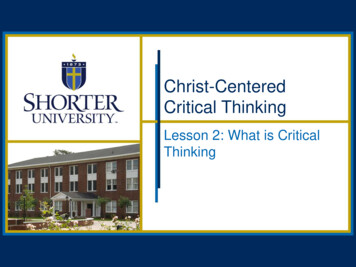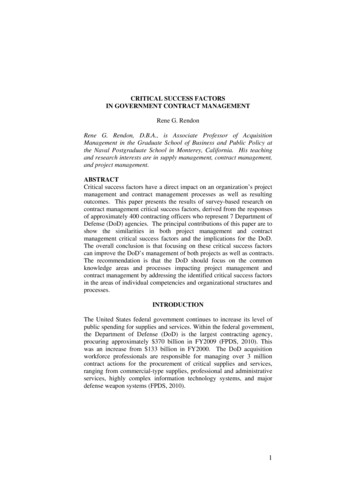
Transcription
CRITICAL SUCCESS FACTORSIN GOVERNMENT CONTRACT MANAGEMENTRene G. RendonRene G. Rendon, D.B.A., is Associate Professor of AcquisitionManagement in the Graduate School of Business and Public Policy atthe Naval Postgraduate School in Monterey, California. His teachingand research interests are in supply management, contract management,and project management.ABSTRACTCritical success factors have a direct impact on an organization’s projectmanagement and contract management processes as well as resultingoutcomes. This paper presents the results of survey-based research oncontract management critical success factors, derived from the responsesof approximately 400 contracting officers who represent 7 Department ofDefense (DoD) agencies. The principal contributions of this paper are toshow the similarities in both project management and contractmanagement critical success factors and the implications for the DoD.The overall conclusion is that focusing on these critical success factorscan improve the DoD’s management of both projects as well as contracts.The recommendation is that the DoD should focus on the commonknowledge areas and processes impacting project management andcontract management by addressing the identified critical success factorsin the areas of individual competencies and organizational structures andprocesses.INTRODUCTIONThe United States federal government continues to increase its level ofpublic spending for supplies and services. Within the federal government,the Department of Defense (DoD) is the largest contracting agency,procuring approximately 370 billion in FY2009 (FPDS, 2010). Thiswas an increase from 133 billion in FY2000. The DoD acquisitionworkforce professionals are responsible for managing over 3 millioncontract actions for the procurement of critical supplies and services,ranging from commercial-type supplies, professional and administrativeservices, highly complex information technology systems, and majordefense weapon systems (FPDS, 2010).1
The extent and amount of defense procurement spending necessitatesthat these contract management processes be well managed (Thai, 2004).However, this is not necessarily the case. Between 2001 and 2009, theGovernment Accountability Office (GAO) has issued 16 reports relatedto trends, challenges, and deficiencies in federal government contracting.Also, between 2002 and 2008, the DoD Inspector General (DoD IG)issued 142 reports on deficiencies in the DoD acquisition and contractadministration processes. These reports have identified projectmanagement and contract management as some of the critical deficientareas in DoD contracts. The essence of DoD contract management is theproper planning, award, and administration of contracts and the oversightof contractor performance (Rendon & Snider, 2008). The lack ofeffective contract administration and contractor oversight increases thegovernment’s risk of jeopardizing the total value for the dollars spent onsupplies and services. GAO and DoD IG reports have consistentlyidentified contract administration and contractor oversight as problemareas in the management of service contracts (GAO, 2005; GAO, 2007;OIG, 2009). The DoD is at risk of paying higher prices than necessaryfor supplies and services. Because of this, the GAO has identified DoDcontract management as a “high-risk” area since 1992 (GAO, 2009,January). This “high-risk” status reflects the DoD’s challenges inachieving desired outcomes in terms of meeting procurement cost,schedule, and performance objectives.In response to this high-risk rating, the DoD is placing an extensiveemphasis in the areas of education, training, and the development ofworkforce competence models (Newell, 2007; GAO, 2009, March). Inaddition to a focus on increasing individual contract managementcompetency, organizations are now focusing on increasing organizationalcontract management competence through the use of organizationalprocess maturity models (Rendon, 2009b). Just as individual competencewill lead to greater success in performing tasks, organizational processcapability will ensure consistent and superior results for the enterprise(Frame, 1999; Kerzner, 2001; Garrett & Rendon, 2005).A stream of research has been generated on organizational contractmanagement process capability. The research is focused on assessing anorganization’s contract management process capability and using theassessment results for determining and implementing process capabilityimprovement initiatives. A Contract Management Maturity Model(CMMM) was first developed and then applied to an Air Force spacesystems contracting agency (Rendon, 2003). The CMMM was then2
applied at various Air Force, Army, and Navy contracting agencies forthe purpose of assessing contract management process capability andidentifying process improvements, as well as obtaining empirical data foruse in characterizing the state of contract management process capabilitythroughout the DoD (Rendon, 2008; Rendon, 2009b).The CMMM organizational assessments have also resulted in obtainingempirical data on contract management critical success factors. Criticalsuccess factors have a direct influence on an agency’s projectmanagement and contract management processes and resultant projectsand contracts.Contract management and project management are integrally related.The management of projects typically includes planning, awarding, andadministering contracts for the performance of the project-related effort.Effective contract administration is integral to successful projectmanagement. Contract administration has often been described as“putting the teeth in project monitoring and control” (Rendon, 2009a, p.70). Indeed, the close relationship between project management andcontract management is reflected in the Project Management Institute’sGuide to the Project Management Body of Knowledge (PMBOK Guide)(PMI, 2008) as well as the National Contract Management Association’sAnnotated Guide to the Contract Management Body of Knowledge(CMBOK) (NCMA, 2006). The PMBOK Guide includes a discussion ofthe procurement knowledge area, and the CMBOK includes a discussionof project management aspects of managing contracts. The recentreports from the GAO and the DoD IG identify both project managementand contract management as deficiencies in the DoD’s contracts. Thus,both project management and contract management are critical processesfor the DoD.If successful project management and contractmanagement processes are critical for the success of the DoD’sacquisition mission, how do critical success factors for projectmanagement compare with critical success factors for contractmanagement? This is the focus of this research.This paper presents the results of survey-based research on contractmanagement critical success factors, derived from the responses ofapproximately 400 contracting officers who represent 7 DoD agencies.An analysis of the survey responses is conducted to identify similaritiesbetween the survey responses and the critical success factors identified inthe project management and contract management literature. Thepurpose of this paper is to compare the project management and contract3
management critical success factors as identified in the literature with thecontract management critical success factors indentified in our surveybased research. The principal contributions of this paper are to show thesimilarities in both project management and contract management criticalsuccess factors and to discuss the implications for the DoD in terms ofindividual and organizational competence. The overall conclusion is thatfocusing on these critical success factors can improve the DoD’smanagement of both its projects and its contracts.This paper is organized in four sections. The remainder of this firstsection provides a brief background on the theoretical framework and aliterature review on identifying critical success factors in projectmanagement and contract management. In the second section, I discussthe research methods, followed by the third section on research findingsand results. Finally, in the fourth section I present a discussion of theidentified critical success factors and compare them with the literature.Theoretical FrameworkAcademic research in contract management is founded on severaleconomic and management theories, the most often referred to is agencytheory (Eisenhardt, 1989). A contract between the government and acontractor reflects a principal-agent relationship.The principal(government) contracts with the agent (contractor) to perform some levelof effort, such as developing or manufacturing a product or providing aservice. In this relationship, the government’s objectives includeobtaining the product or service at the right quality, right quantity, rightsource, right time, and at the right price (Lee & Dobler, 1971). Thefederal government also has the additional objective of ensuring theproduct or service is procured in accordance with public policy andstatutory requirements (FAR, 2010).Contractors, on the other hand pursue the objectives of earning a profit,ensuring company growth, maintaining or increasing market share, andimproving cash flow, just to name a few. Because of the different andconflicting objectives between the principal and agent, each party ismotivated and incentivized to behave in a certain manner. This behaviorincludes either withholding or sharing information. In principal-agentrelationships that involve higher levels of uncertainty, which result inhigher risk (such as developing an advanced technology weapon system),the information available to the government and contractor is typicallyasymmetrical.4
Agency theory is concerned with the conflicting goals between theprincipal and agent in obtaining their respective objectives and is focusedon mechanisms related to obtaining information (for example, about themarketplace, the supply or service, or the contractor), selecting the agent(to counter the problem of adverse selection), and monitoring the agent’sperformance (to counter the effects of moral hazard). Thus, howcontracts are planned (for example, competitive or sole source),structured (fixed price or cost reimbursement, with or without incentives),awarded (based on lowest priced, technically acceptable offer, or thehighest technically rated offer), and administered (centralized ordecentralized, level and type of surveillance, and use of project teams ),has its basis in agency theory and the principal-agent problem. Agencytheory can also be applied to project management, specifically in themanagement of government projects (Moe, 1984). In governmentprojects, the same principal-agent model exists. The principal, in thiscase the project manager, is faced with the problem of ensuring theagents, in this context the members of the project team, will choose topursue the principal’s best interests.Critical success factors have a direct relationship on an organization’sprocesses and resulting outcomes, such as projects and contracts. Thus,their importance is crucial to an organization’s process improvementefforts. The next section of this paper will present a literature review oncritical success factors for project management and contract management.Literature ReviewThis literature review will first focus on the basics of critical successfactors and then transition to success factors in project management andcontract management.There has been much written on the identification and value of criticalsuccess factors in business organizations. Daniel (1961) discussescritical versus non critical elements of a business leading to success.Rockart (1979) identifies the use of critical success factors in helpingexecutives define their information needs. He identifies critical successfactors as the “limited number of areas in which results, if they aresatisfactory, will ensure successful competitive performance for theorganization” (1979, p. 85). Rockart also discusses an interview methodfor determining a manager’s critical success factors. Bullen and Rockart(1981) differentiate critical success factors from other organizationalmanagement terms such as “strategy,” “objective,” “goals,” “measures,”5
and “problems.” They also identify five prime sources of critical successfactors (industry, competitive strategy/industry position, environmentalfactors, temporal factors, and managerial position) and a classificationscheme for critical success factors (internal versus external andmonitoring versus building/adapting), as well as a hierarchy of criticalsuccess factors (industry, corporate, sub-organization, and individual)(Bullen & Rockart, 1981).The project management literature also provides some insight on criticalfactors for project success. However, for a discussion on differentperceptions of what is considered project success, see Pinto and Slevin(1989). Rubin and Seeling (1967) introduce success and failure factorsfor projects and conclude that a project manager’s performance isdetermined more by the size of projects previously managed as opposedto the project manager’s experience. Avots (1969) identifies projectmanager selection, project termination, and top management support asfactors related to project failure. Baker, Murphy, and Fisher (1983)propose using perceived performance as the measure for project success,instead of the usual triple constraints of cost, schedule, and performance.Others such as Hughes (1986) and Morris and Hough (1987) identifyvarious factors related to project failure or success. Schultz, Slevin, andPinto (1987) identify categories of project success factors (strategic andtactical) and the impact these factor categories have on the project duringthe various project management phases. Baccarini (1987) develops alogical framework method for defining project success that consists offour levels of project objectives (goal, purpose, output, and input) anddifferentiates between product success and project management success.Belassi and Tukel (1996) propose a new framework for determiningproject critical success factors, grouping them into four categories—project-related, project team/manager related, organization-related, andexternal environment related.Specifically related to organizational success factors, Frame (1999)identifies seven key elements that lead to organizational competence inproject management: 1) clearly defined and well-formulated proceduresfor performing work, 2) access to information needed to perform workeffectively, 3) sufficient quantities of human and material resources, 4)opportunities for training and education, 5) clearly defined visions ofwhere the organization is headed, 6) a culture of openness, and 7)institutionalization of project management. Crawford (2002) analyzesand compares many of the results of the previous studies of projectsuccess factors and identifies the top six factors: 1) planning6
(integrative); 2) monitoring and control (integrative), team selection, andtechnical performance; 3) communication, leadership, strategic direction,and team development; 4) monitoring and control (risk), organizationalsupport, and stakeholder management (other); 5) organizationalstructure; and 6) project definition and stakeholder management (client).Finally, in a survey of over 150 project management professionals,Baccarini and Collins (2003) identify fifteen critical factors for projectsuccess. These factors, listed in Table 5, will be discussed later in thepaper.The literature on contract management critical success factors is not asextensive as on project management. There are studies on critical successfactors for specific aspects of procurement. For example, Trent andMonczka (1994) identify critical success factors for cross-functionalsourcing teams such as organizational resources, involvement ofsuppliers, decision-making authority, team leadership, and team effort.Monczka, Petersen, Handfield, and Ragatz (1998) identify the followingsuccess factors in strategic supplier alliances: trust and coordination,interdependence, information quality and participation, informationsharing, joint problem solving, avoiding the use of severe conflictresolution tactics, and a formal alliance selection process. Gottschalk andSolli-Saether (2005) researched various management theories andidentify core competence management and stakeholder management asthe most theory-based critical success factors for information technologyoutsourcing. Finally, Angeles and Nath (2007), in their research onsuccess factors for implementing business to business e-procurementpractices, identify three success factors: supplier and contractmanagement, end-user behavior, e-procurement business processes, andinformation and e-procurement infrastructure.Although the literature did not indicate research specifically on criticalsuccess factors for government contract management, a literature searchdid identify best practices and lessons learned in federal governmentcontract management. Cohen and Eimicke (2008) identify twentyproblems in government contracting that fall into five categories: 1)problems relating to letting contracts, 2) communication issues, 3)contractor internal management issues, 4) government contractmanagement issues, and 5) environment or external issues. Additionally,in empirical studies of DoD contracting agencies, Rendon (2009b)identifies five organizational contract management process best practicecategories---1) process strength, 2) successful results, 3) managementsupport, 4) process integration, and 5) process measurement.7
In the next section, I discuss this paper’s research methods and theresearch results. A discussion of the research findings compared to theliterature will then be presented.METHODSThe overall objective of this research is to develop a comprehensiveunderstanding of the critical success factors in public contractmanagement. The specific objective and the research question posedwere driven by the findings of the GAO and DoD IG reports, as well asby the survey of academic literature discussed earlier. Consequently, thisstudy is focused on answering the following research question: What arethe critical success factors needed by DoD contracting agencies toaccomplish their mission? The methodology for this research is similarto accepted techniques (Baccarini & Collins, 2003) and involves the useof a web-based survey instrument with open-ended questions. The surveyincluded the following open-ended question: What are the criticalsuccess factors needed to allow your organization to achieve its mission?The focus of the analysis is to compare the survey responses with theliterature to identify any similarities or differences. (The web-basedsurvey also contained questions related to organizational contractmanagement process capability. An analysis of those responses is thesubject of a separate paper.)The survey used a purposeful sampling method, designed to acquire dataon critical success factors in government contract management.Purposeful sampling ensures samples are knowledgeable and informativeabout the phenomena being researched, thus increasing the utility of theinformation obtained from small samples (McMillan & Schumacher,2001; Creswell, 2003). Therefore, the survey was only administered towarranted contracting officers and fully qualified contract specialists.The sampling in this research consisted of agency employees eitherdesignated as warranted contracting officers or individuals that wereconsidered fully qualified in the government contracting career field, inaccordance with the Defense Acquisition Workforce Improvement Act(DAWIA). Warranted contracting officers are those individuals that havespecific authority to enter into, administer, or terminate contracts andmake related determinations and findings on behalf of the United StatesGovernment (FAR, 2010). Full qualification in the contracting careerfield is interpreted to mean achievement of Level 2 certification incontracting under DAWIA. Level 2 certification requires completion of a8
baccalaureate degree with at least 24 semester hours of coursework inaccounting, law, business, finance, contracts, purchasing, economics,industrial management, marketing, quantitative methods, andorganization and management; two years of contracting experience; andcompletion of the required contract training courses (DAWIA, 2009).During 2008 and 2009, the survey website link was emailed to thecontracting officials for the following DoD contracting agencies:US Transportation Command (TRANSCOM)US Navy Command Fleet Industrial Supply Center (COMFISC)Army Contracting Command Joint Munitions & LethalityContracting Center (ACC JM&L)Army Contracting Command National Capital RegionContracting Center (ACC NCR)Army Contracting Command Aviation and Missile CommandContracting Center (ACC AMCOM)US Special Operations Command (USSOCOM)Department of Defense Educational Activity (DoDEA)The survey was then forwarded to the eligible contracting personnel forcompletion. Reminder emails were sent approximately two weeks intothe survey period. (For TRANSCOM, the surveys were administered viavideo-teleconferencing, completed hard-copy, and returned by mail.) Thesurvey instrument included the appropriate confidentiality and protectionof human subject provisions.Below are profiles of the contracting agencies that participated in thesurvey.US Transportation Command (TRANSCOM). The US TransportationCommand’s (TRANSCOM) mission is to provide air, land, and seatransportation for the Department of Defense, both in times of peace andtimes of war. In support of this mission, USTRANSCOM acquiresdistribution and transportation services for global movement in supportof the warfighter. The directorate of acquisition provides acquisition9
support of USTRANSCOM’s mission. The directorate typicallyprocesses approximately 6,000 contract actions, with an annual spend ofapproximately 6 billion (USTRANSCOM, 2009).Navy Command Fleet Industrial Supply Centers (COMFISCS).COMFISCS is comprised of the following seven individual FISCcommands: FISC-San Diego, FISC-Norfolk, FISC-Puget Sound, FISCPearl Harbor, FISC-Yokosuka, FISC-Sigonella, and FISC-Jacksonville.COMFISCS is responsible for supplying the Navy fleet with a widevariety of supplies and services, including appliances, informationtechnology equipment, office furniture, and ship copiers. Servicesprocured include ship repair, husbanding functions, laundry, consulting,and tugboats. In FY 2008, COMFISCS had completed 89,343contracting actions that obligated a total of 4.2 billion (Bautista & Ward,2009).Army Contracting Command Joint Munitions & LethalityContracting Center (ACC JM&L). Part of the Army ContractingCommand, the Joint Munitions & Lethality (JM&L) Contracting Centeris responsible for providing procurement support for lifecycle programmanagement of armaments and munitions. Some of the systems procuredby JM&L include research and development prototypes to major weaponsystems, such as the Army’s 155mm Precision Guided Extended RangeArtillery Projectile known as Excalibur, XM982. The total JM&Lcontract dollars obligated in FY2008 was 3.5 billion (Puma & Sherr,2009).Army Contracting Command National Capital Region (ACC NCR).The Army Contracting Command National Capital Region ContractingCenter consists of the Contracting Center of Excellence (CCE) and theInformation Technology, E-Commerce and Commercial ContractingCenter (ITEC4). CCE provides contracting support to the ArmySecretariat and the Army Staff for the procurement of telecommunicationequipment and services, advertising, training, and studies. The ITEC4provides worldwide information technology contracting support andprocures enterprise information technology support and equipment forArmy and other DoD activities. During FY2009, CCE awarded 3663actions totaling approximately 1.2 billion. ITEC4 awarded 6,526actions totaling approximately 2.5 billion during fiscal year 2009(Jeffers, 2009).Army Contracting Command Aviation and Missile Command (ACCAMCOM). The Army Aviation and Missile Command (AMCOM) is10
responsible for lifecycle management of Army missile, helicopter,unmanned ground vehicle, and unmanned aerial vehicle weapon systems.These weapon systems include the Patriot air defense missile system,Hellfire and Javelin missile system, and Apache, Black Hawk, andChinook helicopters. The AMCOM Contracting Center providesacquisition and contracting support for these weapon systems. In FY2008,the AMCOM Contracting Center processed approximately 23,600contract actions and obligated approximately 20.6 billion (AMCOM,2009).US Special Operations Command (USSOCOM). USSOCOM SpecialOperations Acquisition and Logistics Center, Directorate of Procurementprocures systems and services in support of the USSOCOM. Thesesystems and services include research and development, equipmentrelated services, knowledge-based services, medical services,construction services, transportation services, and facility-relatedservices. The systems procured include such items as SILENT KNIGHTRadar, Ground Penetrating Radar, Multi-role Anti-armor Anti-personnelWeapon System, Anti-structure Munitions, Advanced LightweightGrenade Launcher, Multiband Inter/Intra Team Radio, and the DynamicOptimal Tag System. In providing support for USSOCOM, thedirectorate procures a myriad of systems and services. In Fiscal Year2007, the directorate spent 737 million on systems and 1.143 billionon services (Anglin & Good, 2009).Department of Defense Educational Activity (DoDEA). DoDEAprovides education to eligible DoD military and civilian dependents frompre-kindergarten through 12th grade; it consists of the Department ofDefense Dependents Schools (DoDDS) located overseas and theDepartment of Defense Domestic Dependent Elementary and SecondarySchools (DDESS) located in the United States and its territories andpossessions. DoDEA procures supplies and services such as textbooksand other educational materials, playground equipment, school bustransportation, information technology, school band uniforms, sportsequipment, and anything else needed by a typical public school system.DoDEA’s annual procurements are typically in excess of 10 million(Neely, 2009).Although each of these DoD agencies procures different supplies andservices, they all comply with the federal contracting statutes and DoDcontract management regulations and policies. In addition, they all11
follow, to some extent, the same contract management lifecycle (Rendon& Snider, 2008).RESULTSThe survey was deployed to the seven agencies discussed in the previoussection. Table 1 shows, for each organization, the number of eligibleresponders from the organization, the number of actual responders, theresponse rate, and the number of actual responses. Of the total 821eligible survey participants, 425 completed the survey, generating aresponse rate of approximately 59%. The 425 survey participantssubmitted a total of 1,531 responses to the open-ended question oncritical success factors.Table 1The responses to the survey question were analyzed to determinesimilarities and, based on the analysis, were grouped into eight categories.Table 2 provides the ranking of the critical success factor categoriesalong with the percentage of responses.Table 212
DISCUSSIONThe qualitative content analysis provides the following insight on criticalsuccess factors for these DoD contracting agencies:Workforce (37%)The Workforce category reflects the largest percentage of surveyresponses. Common responses included statements related to having anadequate number of personnel; proper staffing of vacant positions;continuous hiring and recruitment of personnel; and a trained,experienced, and competent workforce.Also included in this category were responses related to the need forspecific workforce expertise (such as price analyst, quality assurancepersonnel, policy specialists, and procurement analyst) and theestablishment of specific organizational entities (such as a contractadministration team, contract closeout team, full-time policy section,separate small purchase section).Other common responses related to promotion of deserving personnel,removal of non-productive personnel, mentoring of interns and juniorlevel personnel, and empowerment of employees.The Workforce category constituted 566 of the 1,531 responses. Ofthese 566 responses, this category could be broken down intosubcategories of Training (222 responses), Organizational Realignment(33 responses), Experience (28 responses), Promotion (15 responses),and Mentoring (8 responses), as reflected in Table 3. Table 4 provides asample of survey responses related to this category.Table 313
Table 414
Processes (16%)The Processes category constituted 251 of the 1,531 responses.Responses included statements related to having documented,standardized, consistent, efficient, effective, enforced, and streamlinedcontracting processes. The most prominent response specifically relatedto having standardized processes (39). Also included in this categorywere responses related to flexible processes, sufficient time to performspecific processes such as procurement planning, risk management, andthe integration of processes throughout the organization, and price andcost analysis processes. This category also includes responses related tothe use of templates, and processes that were measured and continuouslyimproved through the establishment of lessons learned and best practices.Processes specifically identified in the responses included procurementplanning (28), contract administration (16), source selection (15),solicitation (10), contract closeout (4), and solicitation planning (3). Inaddition, risk management (2) and project management (2) were alsoidentified as critical processes. Table 5 provides a sample of surveyresponses related to this category.15
Table 516
Relationships (15%
contract management is reflected in the Project Management Institute’s Guide to the Project Management Body of Knowledge (PMBOK Guide) (PMI, 2008) as well as the National Contract Management Association’s Annotated Guide to the Contract Management Body of Knowledge (CMBO


